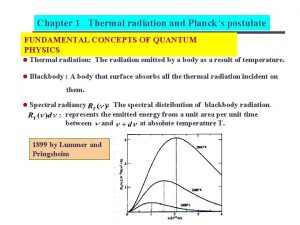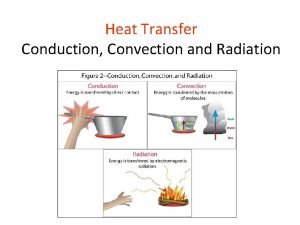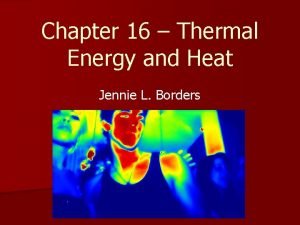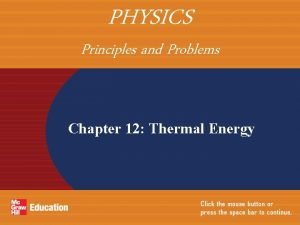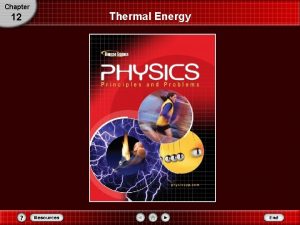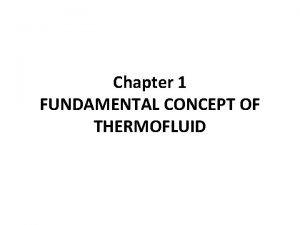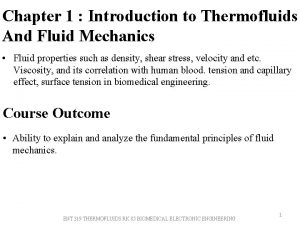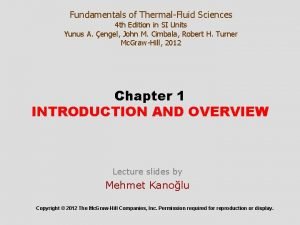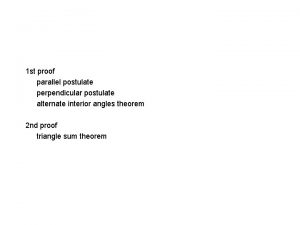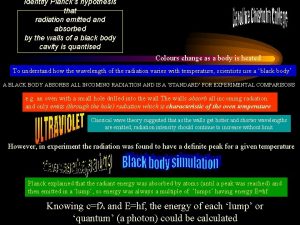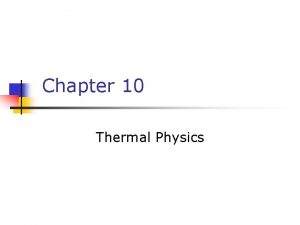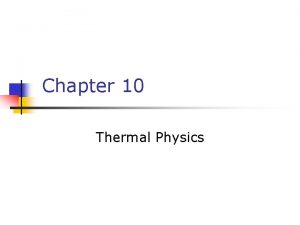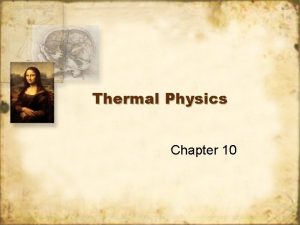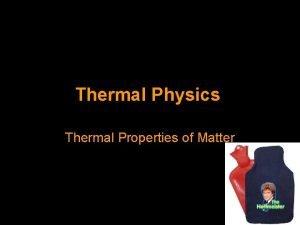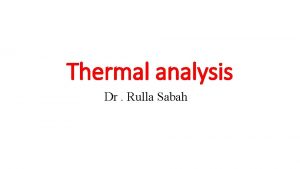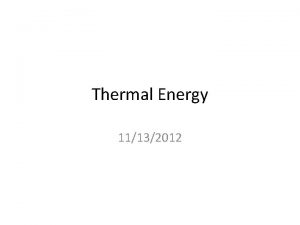Chapter 1 Thermal radiation and Plancks postulate FUNDAMENTAL
















- Slides: 16

Chapter 1 Thermal radiation and Planck’s postulate FUNDAMENTAL CONCEPTS OF QUANTUM PHYSICS l Thermal radiation: The radiation emitted by a body as a result of temperature. l Blackbody : A body that surface absorbs all thermal radiation incident on them. l Spectral radiancy : The spectral distribution of blackbody radiation. represents the emitted energy from a unit area per unit time between and at absolute temperature T. 1899 by Lummer and Pringsheim

Chapter 1 Thermal radiation and Planck’s postulate l The spectral radiancy of blackbody radiation shows that: (1) little power radiation at very low frequency (2) the power radiation increases rapidly as ν increases from very small value. (3) the power radiation is most intense at certain for particular temperature. (4) drops slowly, but continuously as ν increases , and (5) increases linearly with increasing temperature. (6) the total radiation for all ν ( radiancy ) increases less rapidly than linearly with increasing temperature.

Chapter 1 Thermal radiation and Planck’s postulate l Stefan’s law (1879): Stefan-Boltzmann constant l Wien’s displacement (1894): 1. 3 Classical theory of cavity radiation l Rayleigh and Jeans (1900): (1) standing wave with nodes at the metallic surface (2) geometrical arguments count the number of standing waves (3) average total energy depends only on the temperature l one-dimensional cavity: one-dimensional electromagnetic standing wave

Chapter 1 Thermal radiation and Planck’s postulate l for all time t, nodes at standing wave the number of allowed standing wave between ν and ν+dν two polarization states

Chapter 1 Thermal radiation and Planck’s postulate l for three-dimensional cavity the volume of concentric shell The number of allowed electromagnetic standing wave in 3 D Proof: λ/2 propagation direction λ/2 nodal planes

Chapter 1 Thermal radiation and Planck’s postulate for nodes: l considering two polarization state Density of states per unit volume per unit frequency

Chapter 1 Thermal radiation and Planck’s postulate l the law of equipartition energy: For a system of gas molecules in thermal equilibrium at temperature T, the average kinetic energy of a molecules per degree of freedom is k. T/2, is Boltzmann constant. l average total energy of each standing wave : l the energy density between ν and ν+dν: Rayleigh-Jeans blackbody radiation ultraviolet catastrophe

Chapter 1 Thermal radiation and Planck’s postulate 1. 4 Planck’s theory of cavity radiation l Planck’s assumption: and l the origin of equipartition of energy: Boltzmann distribution probability of finding a system with energy between ε and ε+dε

Chapter 1 Thermal radiation and Planck’s postulate l Planck’s assumption: (1) (2) small ν large ν Planck constant Using Planck’s discrete energy to find

Chapter 1 Thermal radiation and Planck’s postulate

Chapter 1 Thermal radiation and Planck’s postulate l energy density between ν and ν+dν: Ex: Show solid angle expanded by d. A is spectral radiancy:

Chapter 1 Thermal radiation and Planck’s postulate Ex: Use the relation between spectral radiancy and energy density, together with Planck’s radiation law, to derive Stefan’s law

Chapter 1 Thermal radiation and Planck’s postulate Ex: Show that Set by consecutive partial integration Fourier series expansion

Chapter 1 Thermal radiation and Planck’s postulate Ex: Derive the Wien displacement law ( ), Solve by plotting: find the intersection point for two functions Y intersection points: X

Chapter 1 Thermal radiation and Planck’s postulate 1. 5 The use of Planck’s radiation law in thermometry optical pyrometer (1) For monochromatic radiation of wave length λ the ratio of the spectral intensities emitted by sources at and is given by standard temperature ( Au ) unknown temperature (2) blackbody radiation supports the big-bang theory.

Chapter 1 Thermal radiation and Planck’s postulate 1. 6 Planck’s Postulate and its implication Planck’s postulate: Any physical entity with one degree of freedom whose “coordinate” is a sinusoidal function of time (i. e. , simple harmonic oscillation can posses only total energy Ex: Find the discrete energy for a pendulum of mass 0. 01 Kg suspended by a string 0. 01 m in length and extreme position at an angle 0. 1 rad. The discreteness in the energy is not so valid.
 Planck postulate
Planck postulate Planck constant
Planck constant Plancks law
Plancks law Can you use the sss postulate or the sas postulate to prove
Can you use the sss postulate or the sas postulate to prove Convection examples
Convection examples Thermal radiation
Thermal radiation Thermal energy section 3 using thermal energy
Thermal energy section 3 using thermal energy Thermal transfer vs direct thermal printing
Thermal transfer vs direct thermal printing Chapter 17 thermal and sound insulation
Chapter 17 thermal and sound insulation Chapter 16 thermal energy and heat
Chapter 16 thermal energy and heat List the properties of x radiation chapter 38
List the properties of x radiation chapter 38 Angle addition postulate find the indicated angle measure
Angle addition postulate find the indicated angle measure Chapter 12 study guide thermal energy
Chapter 12 study guide thermal energy Chapter 12 thermal energy answers
Chapter 12 thermal energy answers Fundamentals of thermal-fluidsciences chapter 1 problem 13p
Fundamentals of thermal-fluidsciences chapter 1 problem 13p Examples of the respiratory system
Examples of the respiratory system Fundamentals of thermal-fluidsciences chapter 2 problem 11p
Fundamentals of thermal-fluidsciences chapter 2 problem 11p
